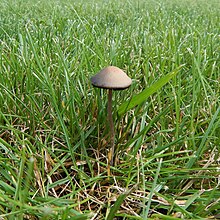Panaeolus fimicola
Appearance
| Panaeolus fimicola | |
|---|---|

| |
| Scientific classification | |
| Domain: | Eukaryota |
| Kingdom: | Fungi |
| Division: | Basidiomycota |
| Class: | Agaricomycetes |
| Order: | Agaricales |
| Family: | Bolbitiaceae |
| Genus: | Panaeolus |
| Species: | P. fimicola
|
| Binomial name | |
| Panaeolus fimicola | |
| Synonyms[1][2][3][4] | |
| |
| Panaeolus fimicola | |
|---|---|
| Gills on hymenium | |
| Cap is convex | |
| Hymenium is adnexed | |
| Stipe is bare | |
| Spore print is black | |
| Ecology is saprotrophic | |
| Edibility is psychoactive | |
Panaeolus fimicola is a widespread but seldom identified "little brown mushroom" which sometimes contains small amounts of the hallucinogen psilocybin. Panaeolus ater is a synonym.[1] The species is also referred to as the "turf mottlegill".[5]
Description
[edit]- Cap: (1)1.5— 3.5(4) cm, Campanulate then convex to plane, obtuse, dingy gray to blackish, often with reddish or hazel tones, hygrophanous, pallid grey to yellowish when dry, smooth, with a narrow brown marginal band, slightly striate at the margin when moist. Flesh thin and grayish.
- Gills: Adnate, close to crowded, at first gray-olivacous, becoming mottled and darkening to black with age, edges remaining whitish.
- Spores: Blackish gray.
- Stipe: (4)6 — 8(10) cm x 1 — 2(3) mm, equal, slender, slightly enlarging at the base, hollow, fragile, dingy white to clay, becoming brownish towards the base in age, smooth, white-pruinose at the apex, obsoletely slightly silky-striate, ring absent. Flesh is dirty ochraceous-buff; fragile.
- Taste: Not distinctive.
- Odor: Not distinctive.
- Microscopic features: Spores 10.8 — 14.2 X 6.9—9.5, ellipsoid or lemon shaped, basidia 4 spored. Gill edge cystidia fusiform, typically with long necks, gill face cystidia absent.
Habitat and formation
[edit]Panaeolus fimicola can be found growing solitary to scattered in soil or dung, fertilized lawns and other grassy places, late spring to mid-fall. It is widespread and common across the Americas, as well as Europe and Africa. It has also been found in Turkey.[6] Panaeolus fimicola will often appear during or after a cold rain.[citation needed]
See also
[edit]References
[edit]- ^ a b Gerhardt, E. (1996). "Taxonomische Revision der Gattungen Panaeolus und Panaeolina (Fungi, Agaricales, Coprinaceae)". Bibliotheca Botanica. 147: 1–149.
- ^ "Panaeolus ater (J.E. Lange) Kühner & Romagn. (1953)". MycoBank. International Mycological Association. Retrieved 2015-10-30.
- ^ "Panaeolus fimicola (Fr.) Quél. (1872)". MycoBank. International Mycological Association. Retrieved 2015-10-30.
- ^ "Panaeolus fimicola var. ater J.E. Lange (1940)". MycoBank. International Mycological Association. Retrieved 2015-10-30.
- ^ "Panaeolus fimicola, Turf Mottlegill, identification". www.first-nature.com. Retrieved 2020-07-26.
- ^ Kaya, Abdullah (2015). "Contributions to the macrofungal diversity of Atatürk Dam Lake basin" (PDF). Turkish Journal of Botany. 39: 162–172. doi:10.3906/bot-1404-70.
- Stamets, Paul (1996). Psilocybin Mushrooms of the World. Berkeley: Ten Speed Press. ISBN 0-9610798-0-0.
